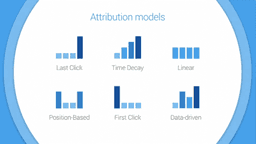
The Importance Of Data Driven Attribution
Written by Caroline
Gone are the days of last click being the be all and end all of attribution. Yes, it’s easier to use and the default option, but it does not credit the legitimate journey that a user takes in order to complete their conversion, and thus skews our ability to create a marketing plan synonymous to actual performance.
What Is Data Driven Attribution?
Google Ads description: Data Driven Attribution distributes credit for the conversion based on past data for this conversion action.
Google launched Data Driven Attribution (DDA) back in 2018, which considers various factors in order to provide legitimate actionable data. As consumer behaviour has become increasingly fragmented with 38% of all customer journeys involving more than one channel of interaction through micro moments – to learn, do, discover, watch or buy something, evolving the customer journey – it is only right that our analysis of performance data reflects this shift also.
DDA identifies click patterns that have resulted in conversions which in turn shows how valuable individual channels, campaign creatives and keywords have been within the process. Implementing DDA has seen to increase conversions by 10% and decrease spend by 5% as a result of optimising to the best performing metrics within your Google Ads account and mitigating any unwarranted spend for keywords/campaigns that are not delivering metrics in line with your clients’ KPIs.
How Can I Use Data Driven Attribution With Google Ads?
Unfortunately, to use DDA within your Google Ads account, there are specific requirements to fulfil, which limits smaller accounts to view their true data landscape.
In my opinion, the following requirements shouldn’t be applicable, as if all accounts were privy to DDA then there will be more valid reasoning to increase activity and in turn develop client spend.
- To Sign Up: 15,000 clicks and 600 conversions per type in 30 days
- To Continue Using DDA After Signing Up: 10,000 clicks and 40 conversions in 30 days
Read the full list of requirements here.
If your client accounts fit the requirements above then you can follow these steps to setup the model:
- Click Tools tab > select Conversions
- Find the conversion action you want to edit > click Edit Settings
- Clicks Attribution Model > select Data Driven Attribution from the drop-down menu
- Click Done > Click Save
Opposed to using DDA within Search Ads 360 (aka DoubleClick for Search) which includes cross channel – Google Ads, Bing Ads, paid social, display and organic – clicks from the user journey, the Google Ads algorithm simply looks at all assets within that channel.
Therefore, despite the limitations within the Google Ads variation, I think it is still definitely the most holistic and well-rounded attribution model to use in order to optimise client accounts with the most actionable data possible rather than the classic first or last click models.
Do you use Data Driven Attribution? We’d love to hear your thoughts about it! Why not let us know on Twitter or Instagram?
Want to discover more digital marketing tips and tricks? Why not sign up to our mailing list for all the latest insights from Flaunt Digital?







